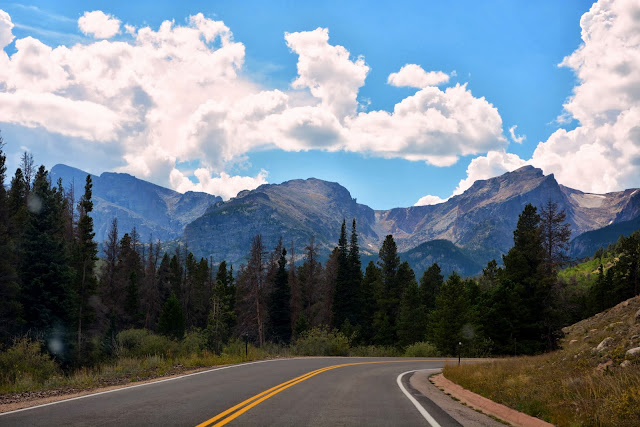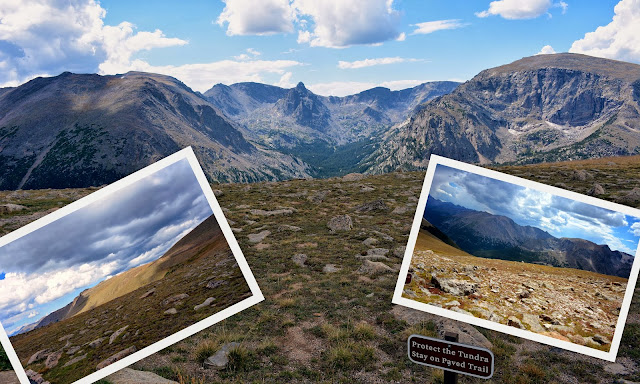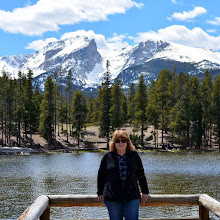I was very excited to visit Rocky Mountain National Park a few weekends ago, and to realize that it is now *almost* in my backyard -- just an hour's drive from where I live! We arrived by taking the Peak to Peak Scenic Highway (see that post on this link) and we stayed two nights right outside the park in a cabin in the YMCA of the Rockies in Estes Park Center (see that post on this link) Please remember that all photos in this post will enlarge for easier viewing, if clicked on once, and then clicked on again to see them full size.
Rocky Mountain National Park is located in northern Colorado and encompasses an area of 416 square miles (265,769 acres). Among its special features are beautiful mountain vistas, as 114 mountain peaks are above 10,00 feet high, 60 are above 12,000 feet and Longs Peak is at 14,259 feet! The park is full of 300 miles of hiking trails, numerous campsites, meadows, and subalpine and alpine vistas, lakes and creeks, thousands of varieties of wild flowers and plants, and chances to see wild animals. Rocky Mountain National Park attracts more than three million visitors a year!
We entered the park at the eastern entrance, located on Highway 35, which is 3.5 miles west of Estes Park. Now that my husband is over 62 years of age, he was able to buy a lifetime senior pass at the entrance station, that enables him (and up to three other people riding in his car, no matter what their age) free lifetime admission to any national park in the USA! Our first stop in the park was at the Beaver Meadows Visitor Center, one mile west of the entrance. There we purchased the wonderful pamphlet that you see above-called Guide to Trail Ridge Road, which I highly recommend, as it greatly increased our appreciation for all we were about to see while driving on the Trail Ridge Road.
All the special interest stops along Trail Ridge Road are numbered "arrowheads" as you see on the bottom of the sign above, and the pamphlet gave uninteresting information about each point.
Trail Ridge Road (US 34) is the highest continuous paved highway in the United States! Covering 48 miles between Estes Park on the east and Grand Lake on the west. Eleven miles of this highway travels above the treeline at elevations near 11,500 feet! It then winds along the tundra to a high point at 12,183 feet! When driving on this road it is hard not to feel as if one is on top of the world! For every 1,000 feet in elevation gained on the road the temperature drops between 3 to 5 degrees Fahrenheit, as if you had driven 600 miles north! Trail Ridge Road was opened in 1932, paved by 1940, and is very well maintained. It is an engineering feat that was built to be a gentle ride both is ascent and descent so that you never have to fear the heights you will attain on it.
At scenic point one, along the Trail Ridge Road, was "Deer Ridge Junction." at 8,940 feet elevation. The road follows a route once used by the Ute and Arapaho Indians, as well as earlier prehistoric people.
The lower elevations favor open meadows inter-spaced with strands of ponderosa pines. These broad-crowned trees have a thick, reddish bark that smells like vanilla in the summer.
We were amused to be stopped at one point by a rafter of wild turkeys that leisurely took their time crossing in front of us on the road!
Trail Ridge Road scenic stop number two, is "Hidden Valley," a former ski downhill ski area, at 9,240 feet elevation. Hidden Valley is today a year-round recreational site offering picnicking, hiking, and winter activities. In winter the snow often lies several feet deep here, and the summers are cool. Subalpine forests of Engelmann spruce and subalpine fir trees live here.
Next stop was stop number 3, "Many Parks Curve," elevation 9, 620 feet. This stop had a grand panorama of many mountain enclosed meadows, and moraines. Moraines are great heaps of rock debris that glaciers pushed or deposited along their sides between 150,000 and 12,000 years ago.
At this vantage point, we could also see multiple rain showers occurring in the distance!
Excuse the windshield window glare in this photo, but I had to include it in this post, as I wish I could describe the delicious smell of all the pine trees we passed in this corridor along the road. I wish I could find a perfume that smelled as good! It was so intoxicating!
As we approached the next stop we passed this sign that announced we were two miles above sea level at 10,560 feet!
There were lots of curves in the road as we ascended higher, but again the Trail Ridge Road is smooth and wide and did not feel dangerous to drive at all.
Stop number four is "Rainbow Curve," at 10,829 feet elevation. You can see portions of the Trail Ridge Road, Hidden Valley and Horseshoe Park in these photos. The Fall River flows through Horseshoe Park. The little chipmunk jumped right up on the rock ledge before me, begging for a handout, but I obeyed the park rules and did not give him any food.
A close up of the alluvial fan of rubble that lies in Horseshoe Park, which can be seen well from this vantage point. The alluvial fan was created by past flood waters that deposited this debris in a matter of hours when a man made an earthen dam at Lawn Lake gave way during the early morning of July 15, 1982. The raging waters deposited boulders, gravel, and sand onto the floor of Horseshoe Park in a rocky layer 44 feet deep! Sadly, this flood killed three people camping in the park that day. You can read the story about this natural disaster on this link. This area also suffered damage from the recent heavy rainfall and flooding and some of the campgrounds had to be closed for repair.
As we drove higher and higher.on the Trail Ridge Road...
...the scenery became more and more spellbinding!
We were leaving the sub-alpine area and entering the alpine section above the tree line!
The next scenic stop was "Forest Canyon Overlook," at 11,716 feet. The stick markers you see along the roadside are there to show snow plow drivers where the road ends when the high snows fall in winter.
Here we had a splendid panorama of Forest Canyon, Hayden Gorge, and Gorge Lakes. The erosive force of glacial ice can be observed in the valley below.
This is also a tundra protected area, where the public is asked to stay on marked trails to preserve the fragile tundra. The word tundra is a Russian word that means "land of no trees." Here wind speed can be over 100 miles an hour, and temperatures remain below freezing at least five months of the year. Because of these harsh conditions and short growing season, tundra plant communities take centuries to form. It would take decades to repair the damage that footsteps would do to them!
Since this post is already long, and I have much more to show you, I will save the rest of my photos of Trail Ridge Road for part two and three, as we have many more beautiful stops ahead. You won't want to miss seeing the next stop, which is part of the "Roof of the Rockies"! There we met some more wild animals and I walked a spectacular tundra trail with sights that are out of this world! Please join me again next post as I know you will enjoy it as much as I am enjoying showing this magnificent park to you!
Click here to read Part Two about the Trail Ridge Road in Rocky Mountain National Park
Click here to read Part Three about the Trail Ridge Road in Rocky Mountain National Park
Click here to read Part Two about the Trail Ridge Road in Rocky Mountain National Park
Click here to read Part Three about the Trail Ridge Road in Rocky Mountain National Park














































































